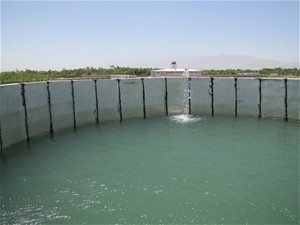
Water from Al Buroni University's new solar water pump spills into a concrete reservoir that feeds the lower farm.
USAID/ACEP/Robert Foster
The high cost of gasoline is replaced by free solar energy
15 NOVEMBER 2011 | KAPISA, AFGHANISTAN
A new solar-powered pump has replaced a gasoline unit at Al Buroni University and is providing 40 cubic meters of water a day for irrigation of the university’s research farms.
The Al Buroni University in Kapisa Province, named after the famous medieval Islamic scholar from the region, serves more than 2,000 students and offers programs in engineering, medicine, law, and literature. The university also has a strong agricultural program, which provides practical education and experience for its students. Demonstration plots are used for crop research and the cultivation of new varieties of forestry, fruit, and nut trees. The agricultural program also maintains vineyards and raises vegetable and cereal crops, some of which provide additional income for the university and food for its students.
For years, the university has relied on gasoline- and diesel-powered pumps to supply the plots with water for drip and furrow irrigation. The fuel for these pumps costs the university thousands of dollars every year. To help reduce costs, USAID recently completed installation of a solar water pumping system at the university.
The newly installed solar unit supplies about 40 cubic meters of water per day for the university’s lower research farm, an area of approximately 4,200 square meters. The water is pumped from an intake reservoir fed by the Panjshir River.
The gasoline pump that used to do this job operated seven hours a day and consumed 14 liters of fuel. During daylight, the new system pumps water continuously to supply irrigation needs with no fuel cost, saving around $6,000 in fuel costs per year. The solar pump also eliminates the gasoline exhaust and CO2 emissions that used to pollute the environment.
Labeb, the director of the university’s faculty of agriculture, is elated to have the solar pump. “Before USAID installed this new pump, we couldn’t afford fuel for the gasoline pump, so we didn’t have enough water to develop some parts of the farm,” he said. “Now we’re able to irrigate those areas and our students have a chance to learn practical aspects of agriculture out in the fields.”







Comment
Make a general inquiry or suggest an improvement.